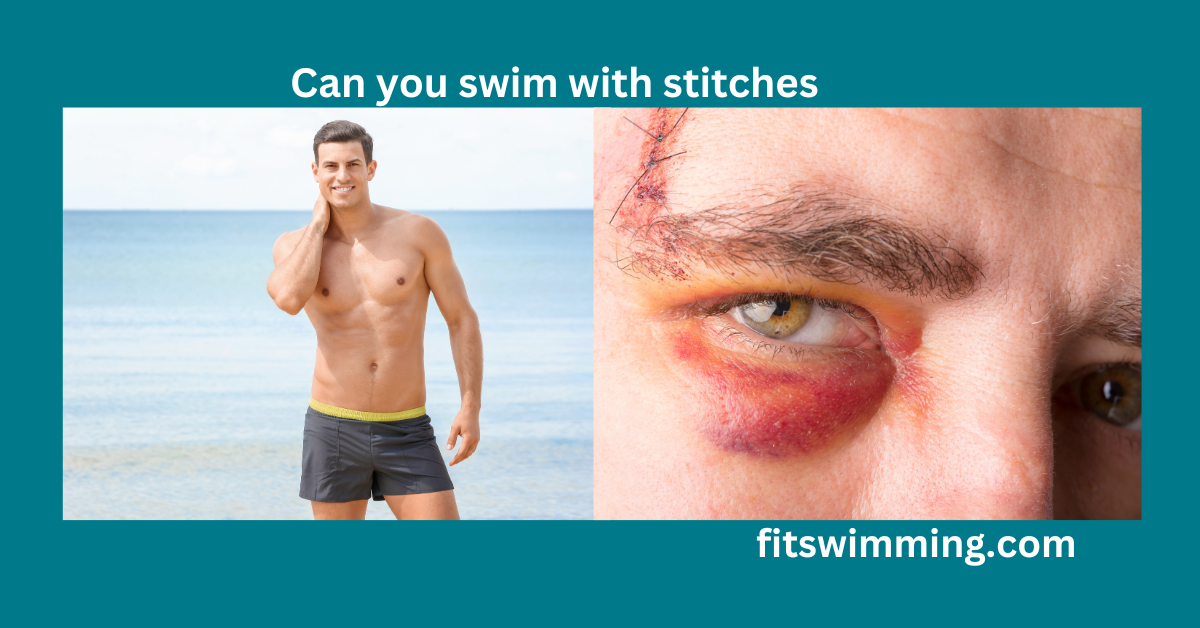Can You Swim With Stitches? Complete Guide
Swimming is an interesting activity and offers a refreshing escape from the summer heat. It is the best way to stay active. If you find yourself in the unlucky situation of having stitches due to a recent injury or surgery, you might be wondering if it’s safe to take a dip in the pool or dive into the ocean. A question always knocks you “can you swim with stitches”? This is a key question that needs careful thinking. If you start swimming too early or without being careful, it can affect how your body heals.
In this article, we will talk about the topic of swimming with stitches, discussing the types of stitches: the guidelines to follow and the precautions to take to ensure your well-being. We will also discuss the alternate techniques of swimming due to stitches. Finding the right balance is really important when you’re thinking about whether or not it’s okay to swim when you have stitches.
Let’s start to discuss in detail the facts about swimming with stitches.
Swimming With Stitches
“Can you go swimming with stitches?” is a question that rises when someone has stitches due to an injury or surgery and does not know about the safety of swimming. The answer depends on a few factors. Generally, it is not recommended to swim with fresh stitches. Swimming with stitches brings risks such as infection and reopening the wound, which can delay the healing process.
Bacteria in the water can cause infections, and the forceful movement of water can damage the stitches. It is important to follow the advice of healthcare professionals and wait until the stitches are removed or dissolved, and the wound has healed sufficiently before swimming. If swimming is necessary during the healing process, it is crucial to consult with a healthcare provider and take precautions by using waterproof bandages to protect the wound.

Here one more question arises in our minds can you swim with stitches after 7 days?
Whether or not you can swim with stitches after 7 days depends on the specific instructions provided by your healthcare provider and the condition of your wound. In some cases, after 7 days, stitches may be removed or dissolved. The wound may have sufficiently healed to allow swimming. You must take advice from your healthcare provider before making a decision. They will evaluate your wound’s progress and provide guidance based on its specific characteristics.
Can You Swim in a Chlorinated Pool With Stitches
Swimming in a chlorinated pool with stitches is generally not recommended, especially during the initial healing period. Chlorine is a chemical commonly used in pools to kill bacteria and maintain cleanliness. While chlorine helps disinfect the water, it can still pose risks to healing wounds.
Chlorinated water can potentially irritate the wound and increase the risk of infection. The chlorine may cause the stitches to break down or dissolve prematurely, compromising the wound closure. The forceful movement of water in a pool can also strain the stitches, leading to the possible reopening of the wound.
Listen to your healthcare provider regarding swimming with stitches. They may provide specific instructions or timelines for when it is safe to swim in a chlorinated pool. In the next, we are ready to discuss the types of stitches.
Types of Stitches
There are a few types of stitches commonly used in wound closure.
Interrupted Stitches
This is the most common type of stitch. Each stitch is individually placed, with the needle passing through the skin on one side, crossing the wound, and exiting on the other side. The thread is tied off after each stitch.
Continuous Stitches
Also known as running stitches, these involve a continuous thread passing through the wound, creating a series of loops or knots. This type of stitch is faster to place but may be more challenging to adjust the tension and can result in the entire stitch line unraveling if one stitch is broken.
Subcuticular Stitches
These stitches are placed beneath the surface of the skin. The stitches are not visible externally, as they are placed within the dermis layer.
Vertical Mattress Stitches
This type of stitch involves placing a stitch on one side of the wound, crossing the wound, and then passing the needle back through the other side, creating a vertical shape. This stitch helps to provide more secure wound closure. It is commonly used for wounds under tension or in areas prone to gaping.
Horizontal mattress stitches Similar to vertical mattress stitches, these stitches involve placing a stitch on one side of the wound, crossing the wound, and then passing the needle back through the other side. However, in horizontal mattress stitches, the needle exits the skin on the same side as it entered, creating a horizontal loop.
Factors to Consider Before Swimming with Stitches
Before swimming with stitches, there are some key factors to discuss:
Healing Stage
Consider the stage of healing for your wound. New stitches need time to heal properly, and swimming can increase the risk of complications.
Healthcare provider’s advice
Consult your healthcare provider for their specific recommendations before swimming with stitches.
Wound Location and Size
The location and size of the wound are important factors to consider. Some areas, such as joints or areas prone to friction, may require longer healing times and more protection before swimming.
Water Environment
Consider the water environment in which you plan to swim. Pools, lakes, and oceans can contain various bacteria and microorganisms that can increase the risk of infection. Chlorinated pools may have different effects on the stitches compared to natural bodies of water.
Precautions and Protection
If your healthcare provider approves swimming, follow their instructions for precautions and protection. This may involve using waterproof bandages or dressings to cover the wound. It ensures proper wound care before and after swimming.
Precautions to Take While Swimming with Stitches
When swimming with stitches, it is important to take certain precautions to minimize the risk of complications and ensure the safety of your wound. Here are some precautions to consider:
Wait for the Appropriate Healing Time
Follow the recommended healing time provided by your healthcare provider before swimming. Fresh stitches need time to properly heal, and swimming too soon can increase the risk of infection and wound reopening.
Use Waterproof Bandages
Cover the wound with a waterproof bandage or dressing specifically designed for water activities. This can help protect the stitches from water exposure and reduce the risk of infection.
Avoid Vital Activities
Refrain from engaging in vital swimming or activities that may stress the stitches. Forceful movements can potentially cause the stitches to tear or break, leading to complications.
Keep the Wound Clean
Before and after swimming, clean the proper wound. Treat your wounds as per your instructor’s instructions.
Monitor for signs of infection
Follow post-swim Care
After swimming, remove the waterproof bandage or dressing and clean the wound according to your healthcare provider’s instructions. Apply any necessary wound care products or medications as recommended. With the knowledge of swimming with stitches, read the article on hair extension swimming.
Alternatives to Swimming with Stitches
If you are unable to swim with stitches due to the healing process, there are alternative activities you can consider to stay active. You can enjoy your time while allowing your wound to heal properly. Here are some alternatives to swimming.
Walking
Walking is a gentle exercise that can keep you active without causing any stress on your stitches. Take regular walks in your neighborhood, at a nearby park, or on a treadmill to maintain your fitness levels.
Cycling
Biking is an easy exercise that doesn’t form your body too hard. It can be a good choice if you can’t swim. You can ride a bike outside or use a stationary bike inside to make your heart beat faster.
Yoga
Yoga is a calm and gentle exercise that helps you become more flexible, strong, and balanced. They can be modified to accommodate your healing process and provide a low-impact workout.
Tai Chi
Tai Chi is a slow and flowing martial art that promotes relaxation, balance, and flexibility. It can be a suitable alternative if you’re looking for a calming and gentle activity during your healing period.
Strength Training
Focus on strength training exercises that target areas of your body not affected by the stitches. You can do different exercises like lifting weights, using stretchy bands, or doing bodyweight exercises like push-ups, squats, and lunges.
Water Exercises
If submerging the wound is not recommended, you can still engage in water exercises that keep the wound above the water surface. Water aerobics or water walking in a pool can provide a low-impact workout while minimizing the risk to your stitches.
FAQ’s
It’s important to wait until your stitches are fully healed before swimming. The time it takes for stitches to heal can vary depending on factors like the type and location of the wound. In general, stitches are typically removed or dissolved within 5 to 14 days.
To protect stitches while swimming, you can use waterproof bandages or dressings. These are specially designed to create a barrier between the water and your stitches, helping to keep them dry and reduce the risk of infection.
It is generally not recommended to get water on stitches. Water can increase the risk of infection and may cause the stitches to loosen or break. It’s important to protect your stitches from water by using waterproof bandages or dressings. It’s best to follow the advice of your healthcare provider and avoid getting water on your stitches until they are fully healed.
Clean and dry the wound: Before applying any waterproofing method, ensure that the wound is clean and dry. Follow the instructions provided by your healthcare provider for proper wound cleaning.
Use waterproof bandages or dressings: Select waterproof bandages or dressings specifically designed for water activities. These products have a special adhesive or material that helps prevent water from seeping into the wound.
Apply the waterproof bandage: Carefully place the waterproof bandage over the wound, ensuring it covers the entire area. Smooth out any wrinkles or air bubbles to create a secure seal.







